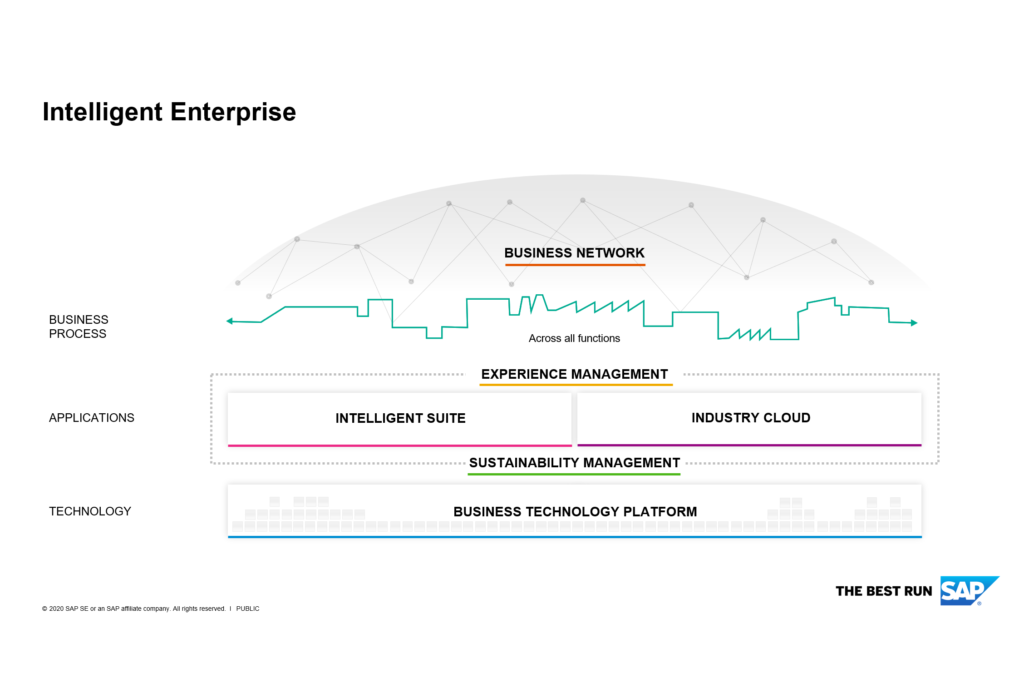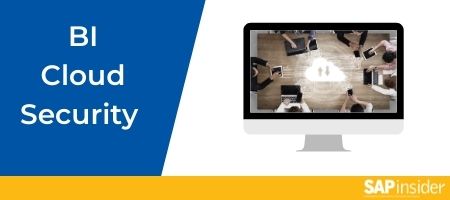Beyond “Back to Best”
By Brianna Shipley, Senior Editor, SAPinsider
When the COVID-19 pandemic shut down the input and output of entire countries, eliminated the opportunity for nearly all nonessential in-person experiences, and required prompt changes to business operations, organizations were put under immense pressure to go digital, as quickly as possible, or risk losing ground to competitors. This phenomenon forced companies to catapult their digital transformation journeys forward to survive. Those organizations least impacted by the crisis had either already completed a digital transformation of key business areas, or at least demonstrated they could quickly implement new digital practices and processes.
A theme emerged globally: Companies that view the impacts of the pandemic as an opportunity, rather than a disruption, will benefit moving forward. To help its customers make this view a reality, SAP launched its “back to best” recommendations, which guide businesses through a set of action items, advanced technologies, and tools — including a combination of SAP and SAP partner solutions — to help them become more resilient and agile, and ultimately run as intelligent enterprises. As any good innovator does, SAP has continued to hypothesize about what could be possible if certain forward-thinking scenarios were to become reality. In these imaginings, the company’s strategy for becoming an intelligent enterprise has evolved, encouraging businesses to not only get back to best, but back to the future.
What Does Becoming an Intelligent Enterprise Mean?
Becoming an intelligent enterprise is a journey, and the strategic guidance SAP provides is based on certain characteristics of best-run businesses. Companies that have reached this status are defined by SAP as those that apply technologies and best practices within agile, integrated business processes. As a result, these companies are more likely to experience resiliency, profitability, and sustainability, according to Andrew Cabanski-Dunning, Vice President of Intelligent Enterprise Marketing at SAP.
He says, “A business does not need to have every component in SAP’s portfolio to become an intelligent enterprise. Instead, companies should take an additive or modular approach to their journey. SAP’s view is that as more areas of your organization adopt an intelligent enterprise strategy, your company will become more streamlined and integrated, resulting in more valuable insights. The more insights your business takes action on, the more intelligent it becomes.”
The expansion of SAP’s intelligent enterprise strategy, originally announced in 2018, continues to be influenced by customer needs (Figure 1). Recommendations include improving data and process integration and infusing advanced technologies — such as artificial intelligence and machine learning — into these processes. In 2019, the acquisition of Qualtrics added a new dimension, with a focus on delivering better experiences to customers, partners, employees, and other stakeholders. Today, digital transformation is critical to a business’s ability to adapt quickly to rapid shifts in the market. More than ever, adopting a digital backbone serves as the foundation for a business’s ability to survive — whether the times call for recovering from a global pandemic or continuously navigating a world subject to recurrent change.

Figure 1 — SAP’s expanded strategy helps optimize intelligent enterprises for the unique needs of each industry, connect them to create a new networked economy, and pursue their climate change objectives
Becoming a Resilient Business Today
Just as business models have shifted to allow for new opportunities and additional revenue streams, so too has the essential mission of many organizations. While remaining competitive was top of mind for most companies prior to the pandemic, as organizations around the world enter the recovery phase, a layer has been added to this focus — the need to bounce back from disruption quickly.
SAP has found that companies using innovative technologies were more competitive before the crisis, and are now more resilient in the crisis. Additionally, businesses that enabled new digital business models, drove automation, and adapted their supply chains were better prepared for the unexpected. Companies must master the ability to recover quickly before they can focus on profitability and sustainability, and SAP has identified doing so as the first phase for businesses entering recovery.
Cabanski-Dunning says, “Today, resilience means identifying what we can do to keep our business as stable as possible and functioning as well as we can to make sure that when the economy turns around, we’re in the best possible position.”
The airline industry has been one of the hardest hit as a result of the crisis, and an important aspect of its recovery strategy is customer engagement. “Airline businesses in particular have had to maintain contact and regularly check the pulse of their customers so travelers don’t trade in their future air travel plans for an alternate airline or substitute mode of travel,” says Helen Dwight, Global Vice President, Head of Marketing Intelligent Enterprise and Industries at SAP.
To keep connected to customers, some airlines have created regular touchpoints, such as surveying customers to understand when they will be ready to travel again and what they might need to feel safe, and sending loyalty club members the magazines they would normally read during their flights.
Airlines’ approach to remaining engaged with their customers falls in line with one of the pathways included in SAP’s strategic recommendations for turning intelligence into action, which is to deliver engaging, trusted, and connected customer experiences. Airlines that have pivoted their approach to meet air quality, cleanliness, and social distancing demands — in response to the popular notion that flying might pose a safety hazard — are succeeding in imagining what the future can look like.
“Staying connected to customers during this time is critical and delicate. You don’t want to oversell, and you’re constantly trying to figure out when is the right time to ramp up promotion,” says Dwight. “The current experience is — and has to be — one of basic safety in the air. Some airlines are offering round-trip scenic flights to nowhere to remain relevant. On the ground, others are creating pop-up restaurants emulating the onboard dining experience. Creativity and interconnectedness are the name of the game.”
Resilience Requires Reimagining
Launching new business models, standardizing processes, and increasing scale without adding complexity have always been ingrained in SAP’s guidance to becoming an intelligent enterprise. The same advice still applies now as businesses brace for a possible second wave and enter, hopefully soon, the recovery phase. SAP recommends identifying and developing vertical, or industry-specific, processes as a best practice for moving forward.
To understand this concept, consider how the connected asset operations process becomes vertical when it is applied to the energy and transportation industries. When exercised in the energy industry, connected asset operations addresses content management, meter data/exchanges, and customer engagement. When the process is employed in the transportation industry, it addresses logistics network data, transportation equipment/vehicles, logistics services networks, and customer engagement.
Although this process relates to one common area between the two industries — customer engagement — the way it is used to meet customer expectations is specific to each industry. According to SAP, common ground is found in what this process or scenario helps each industry achieve. In this example, both industries gain operational efficiencies and increased asset utilization without risking customer satisfaction. This achievement further breaks down departmental silos, a fundamental requirement for agility and digital transformation.
SAP and its partners are innovating with industry cloud solutions to help organizations meet the unique needs of their industry. The development of and access to these solutions — which are built on SAP Cloud Platform with an open application programming interface (API) framework, business services, and data and process models — function similar to an app store. According to Cabanski-Dunning, the intention is for companies to use this space to extend SAP core processes with solutions developed by next-practice innovators, including traditional partners, universities, and start-ups. “You can discover new applications and if you like something, you can take it to the next step, and you know it will integrate with the processes you already have, because it wouldn’t be on industry cloud if it didn’t work with SAP core solutions,” he says.
“The ability for businesses to find an application that meets their needs, is supported, and is compatible with their IT environment is very powerful,” says Dwight.
What It Means to Be Agile in the Face of Disruption
To become an intelligent enterprise, a business should ideally be profitable. “Profitability for a business means getting back to spending and hiring at normal levels but doing it in a way that the business can grow without having to make critical sacrifices,” says Cabanski-Dunning.
Profitability can be achieved through integration, innovation, and agility, which are three key values of SAP’s intelligent enterprise strategy. According to Dwight, intelligent enterprises can achieve agility through data and process integration, which then allows them to understand the big picture and make decisions faster. “An intelligent enterprise uses technology in a way that allows it to identify the entire picture of what is happening in its business, not just a slice of what’s going on,” she says. “This visibility and automation are achieved through integration and use of intelligent technologies such as IoT, machine learning, and artificial intelligence, which can help to quickly identify problems and allow for learning and analysis to holistically solve the problem.”
To understand how integration and agility work hand in hand to help businesses be profitable in a sustainable way, consider how systems integration could benefit a food distributor. Most companies use different systems to support functions such as finance and accounting, production, customer service, and support.
“Now it’s possible for a consumer to understand exactly where the fruit was picked, by whom, when, and more importantly, if sustainable practices were used in bringing it to the breakfast table,” says Dwight. “And with the use of technology such as sensors, machine learning, and artificial intelligence, farmers are able to get smarter about where and when they plant crops and the use of nutrients to provide a greater yield.” Creating an environment of connectedness, she says, could make virtually any scenario a reality.
The recent global crisis has highlighted the necessity of systems integration to allow businesses to be agile, innovative, and profitable in the face of disruption. Coats, for example, a leading thread manufacturer, was able to transform its factory operations to meet the demand for personal protective equipment (such as masks and gowns) when the pandemic hit. In this video, the company attributes its ability to pivot to its digital backbone and shares how it likely would not have achieved the shift with point solutions or spreadsheets.
Having an integrated digital system in place saved lives in Morocco. Before the pandemic hit, the country had no digital system to monitor COVID-19. SAP partner Algo helped set up SAP Digital Boardroom for the Ministry of Health in Morocco in just two weeks, allowing the ministry to collect and analyze data in real time and providing country-wide tracking and increased transparency.
“The key for all these companies is having technology behind the scenes to help them put the right solutions in place,” says Dwight. “These solutions allow either people or the technology itself to decide how to respond in the right way, at the right time.”
Investing in the Future
Incorporating sustainability into the conversation and addressing climate change are important initiatives for SAP, according to Cabanski-Dunning. “We need to collectively create sustainable businesses, sustainable markets, and more recyclable products,” he says. “SAP is in a unique situation to be able to work with so many of the world’s largest companies — we can help them and do this together.”
Climate-related regulation is expanding, and businesses on their intelligent enterprise journey need to make their business models, product portfolios, operations, and supply chains adaptable to these necessary changes. Through SAP’s newly launched Climate 21 program, the company will help businesses minimize their greenhouse gas footprint by building analytical and transactional capabilities into SAP enterprise applications.
The company’s efforts are a direct reflection of SAP’s core values as a company, as well as customer preferences and demands, one of which is increased visibility into the full carbon footprint of the individual products that they purchase. The first solution developed in SAP’s Climate 21 program, SAP Product Carbon Footprint Analytics, was created specifically to help enterprises analyze multiple production sites and take steps to deliver product-specific carbon footprints to their customers.
SAP is empowering companies not only to think about what addressing climate change and sustainability means for them as an individual entity, but also to look beyond their own walls. It is enabling them to relish in the spirit of digital connection by sharing information and processes across networks to do business more efficiently and collaboratively, as well as build ecosystems that allow companies to work together toward a more sustainable future. SAP offerings such as SAP Ariba, SAP Concur, and SAP Fieldglass solutions have been supporting the concept of business networks for years, and SAP sees an opportunity to expand in this area.
“Transportation, for example, can be an issue for many businesses. Many of the trucks you see on the road are not full,” says Cabanski-Dunning. “Imagine a situation where businesses can collectively manage their transportation by seamlessly exchanging information about how much product they have, how much it weighs, where it needs to go, in what time frame, and about which trucks are available where.”
Companies could find themselves paying for a third of the cost of a truck, reducing not only their monetary cost but also the impact on the environment by reducing the number of trucks on the road and moving products more efficiently and sustainably.
Cabanski-Dunning says, “Profitability will be foremost on people’s minds as we go through recovery, but SAP wants that recovery to continue. We want the spirit of innovation and the investment that people have made in running their businesses to reach new levels of efficiency and sustainability. SAP doesn’t just want to go back to business as it was. We want people thinking, how can I reach that next level? How can I be one of the best-run businesses in the world?”
To understand the value of interconnectedness and having an intelligent enterprise strategy, watch this demonstration.







